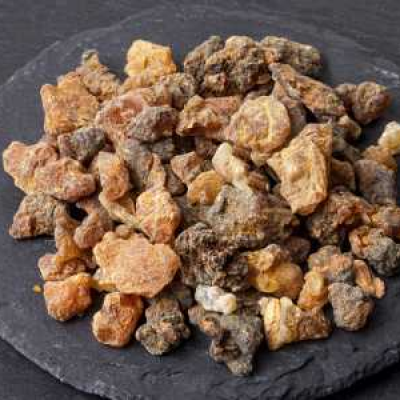- +033 2572 7171
- info@dhanvantary.com

4.5 Rating | 4500 Review

4.5 Rating | 4500 Review
Commiphora wightii is known with a name, Guggulu or Indian bdellium. It belongs to Burseraceae family that contain both trees and shrubs. This is a kind of small tree, grows up to 6 m with spiral, brown colored ascending branches ending in sharp scented spines. This plant has shiny, yellowish white barks that comes off in rough scales exposing under bark of green color. This under bark also seals off in the form of papery rolls. Guggul is the name given to a yellow color resin produced by its stem.

Plant leaves are of small shape with quadrilateral, vessel like structure, present one to three in number. These plants have shiny green on the top, leathery and greyish below with irregular edges. Flowers are unisexual, small, of brown red color, sessile with oblong-ovoid ovary. These can present either in group of two to three or single. Fruits of these plants are of ovoid shape, reddish colored with six to eight mm in diameter. Seeds contain an under developed embryo. Their generic name is derived from Greek word kommis and phora which means gum bearer.
Kingdom
Plantae
Subkingdom
Tracheobionta
Division
Magnoliophyta
Class
Spermatopsida
Subclass
Magnoliidae
Order
Sapindales
Family
Burseraceae
Genus
Commiphora
Species
wightii
The Commiphora wightii or Guggulu is distributed in the rocky tracts of Gujarat, Rajasthan and Mysore in India. Sindh and Baluchistan of Pakistan. Earlier this plant grew abundant in Gujarat and Rajasthan but now days mainly develop in kachchh and saurashtra regions of Gujarat.
|
Hindi / Sanskrit |
English |
||
|
Rasa |
Tikta, Katu |
Taste |
Bitter, Pungent |
|
Guna |
Ruksham, Laghu |
Physical Property |
Dry, Light |
|
Virya |
Ushna |
Potency |
Hot |
|
Vipaka |
Katu |
Metabolic Property (After Digestion) |
Pungent |
Guggulu herb balances all three Doshas: Vata, Pitta and Kapha.
|
Charak Samhita |
Sushrut Samhita |
Vagbhata |
|
Sanjnasthapana – (Restores senses) |
Eladi |
Eladi |
Gum
